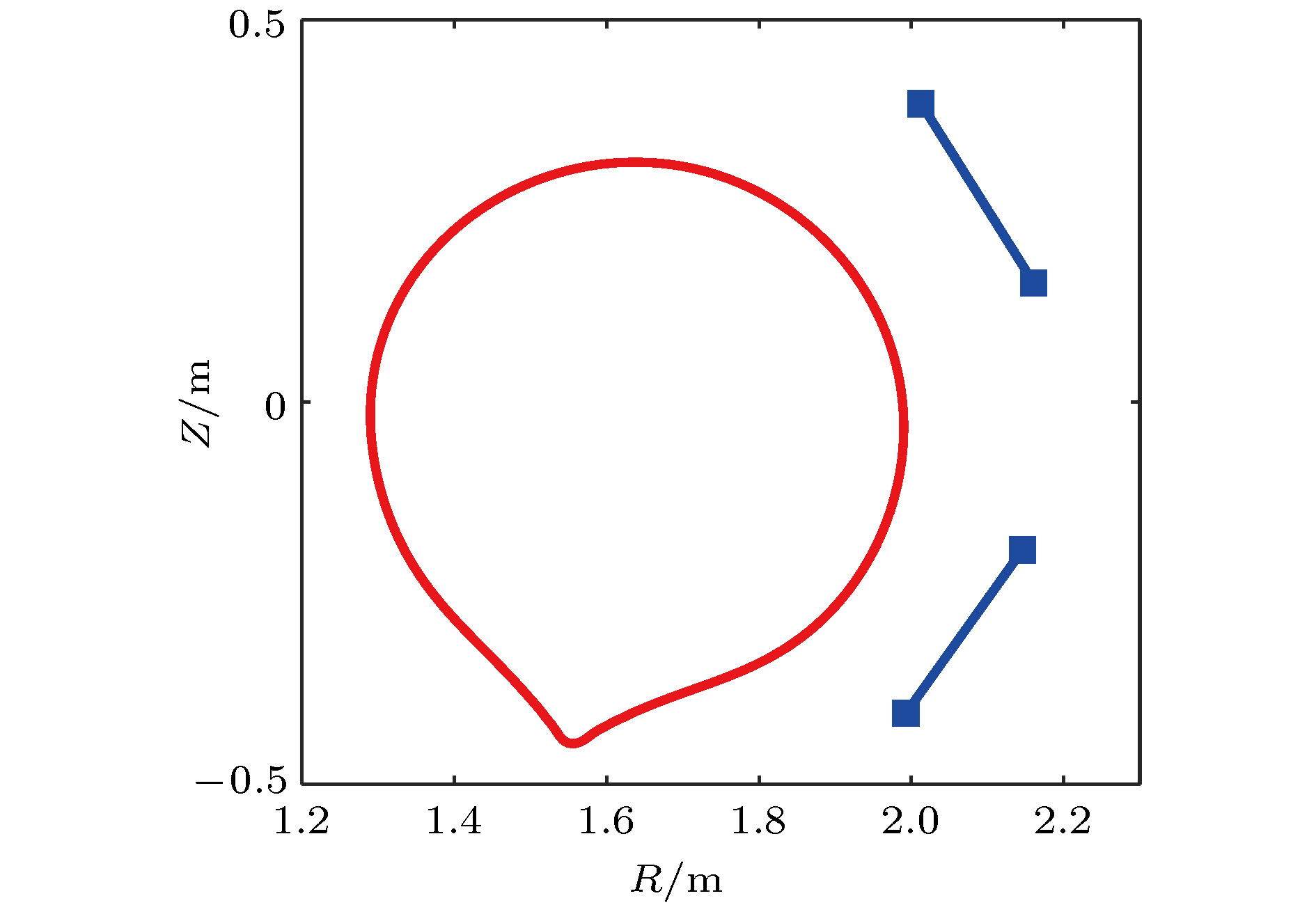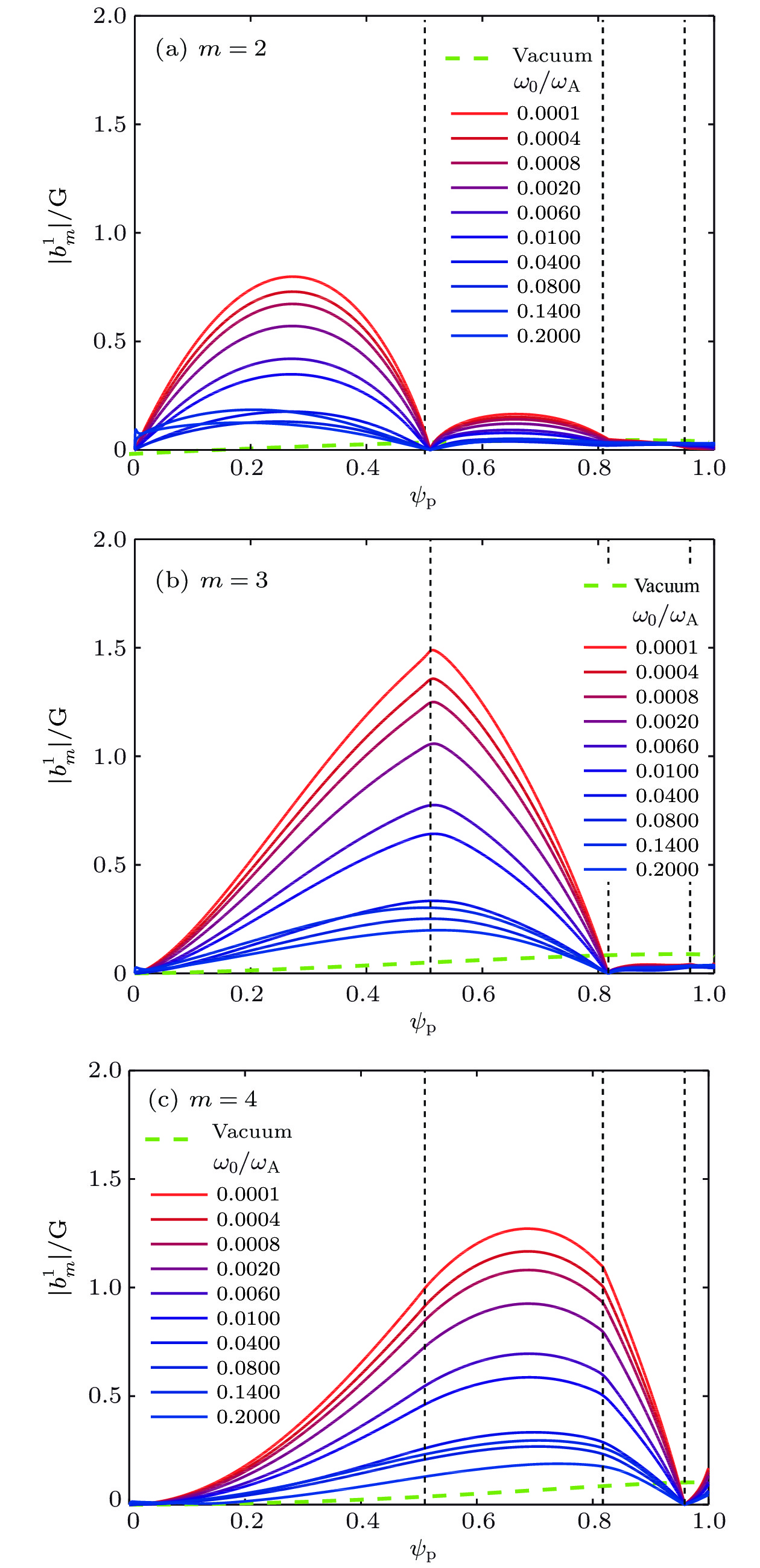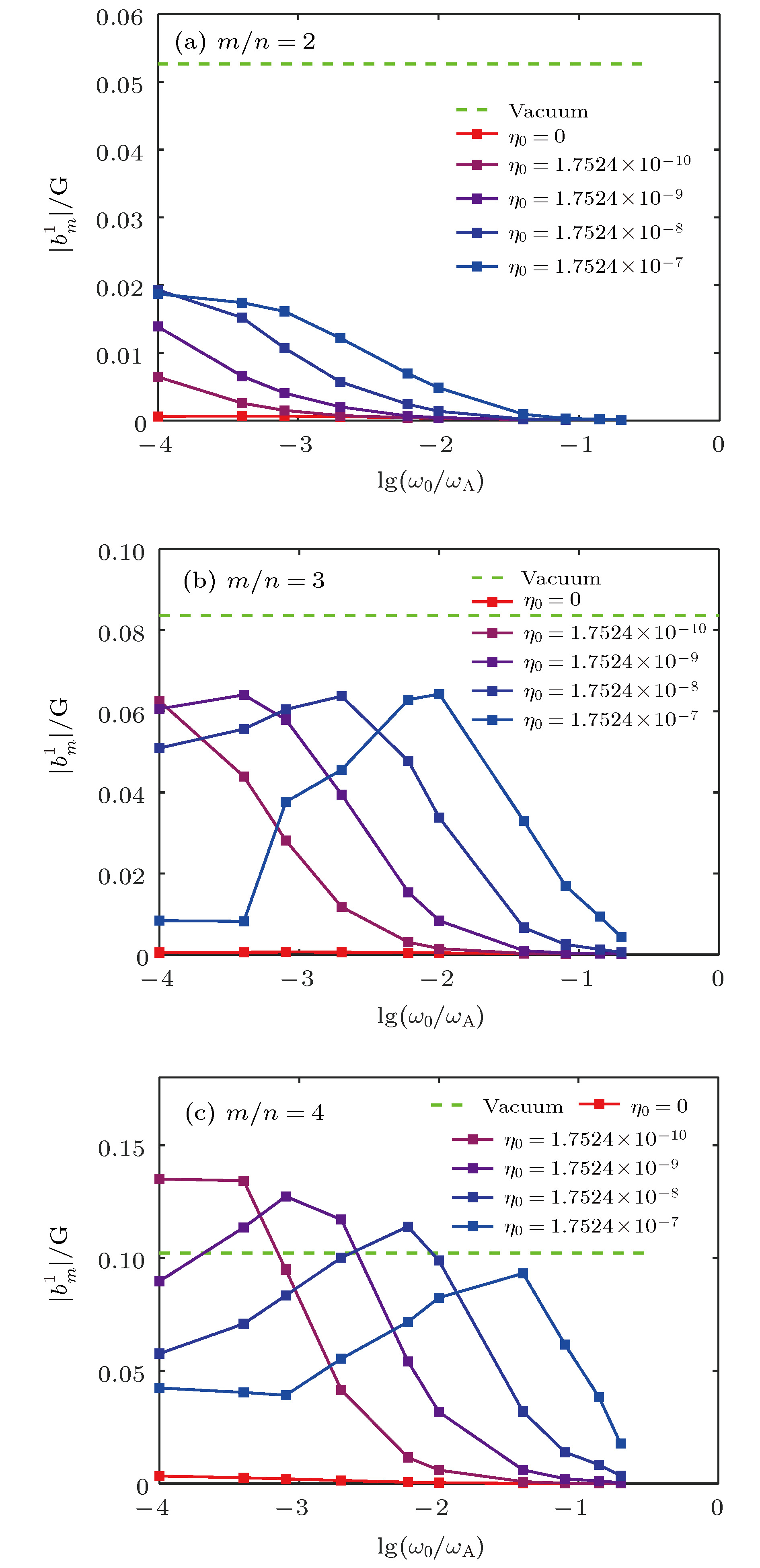-
Resonant magnetic perturbation (RMP), generated by externally applied magnetic perturbation coils, is an important method of controlling plasma edge localized mode. Many experiments have shown that RMP can effectively mitigate/suppress edge localized mode, but its intrinsic physical mechanism is not completely clear. The response of plasma to RMP is the key to understanding the RMP physics. In the presence of RMP, the circumferential symmetry of the tokamak magnetic field will be broken, forming a new three-dimensional(3D) equilibrium, and this process is called the plasma response to RMP. Currently, the parameter range and control effect of RMPs to control edge localized mode on different devices are quite different, implying that the plasma response to RMPs has different response results in different parameter ranges on different devices. Therefore, it is necessary to study the RMP response characteristics of specific devices. In this work, the effect of the plasma rotation frequency on the linear response process of plasma to the resonant magnetic perturbations is investigated in the framework of MARS-F in the HL-2A configuration, and the physical reasons are analyzed in detail. It is found that the shielding and amplification effects in plasma response do not change linearly with plasma rotation frequency, since the plasma resistivity plays an important role. The shielding effect for the magnetic perturbation on the rational surface is enhanced with the increase of the rotation frequency in the high rotation frequency range. However, this rule no longer holds true in the low rotation frequency range due to the deviation of the strongest shielding position from the rational surface caused by the plasma resistivity. As for the amplification effect, the resistivity weakens the amplification effect of plasma response due to the dissipation of induced current. The variation trend of the amplification effect with the rotation frequency and resistivity is consistent with that of the core-kink response, which indicates that the amplification effect of the magnetic perturbation is mainly caused by the core-kink response. -
Keywords:
- tokamak /
- plasma response /
- rotation frequency /
- resonant magnetic perturbations /
- resistive effect
[1] Evans T E, Moyer R A, Watkins J G, Osborne T H, Thomas P R, Bécoulet M, Boedo J A, Doyle E J, Fenstermacher M E, Finken K H, Groebner R J, Groth M, Harris J H, Jackson G L, LaHaye R J, Lasnier C J, Masuzaki S, Ohyabu N, Pretty G L, Reimerdes H, Rhodes T L, Rudakov D L, Schaffer M J, Wade M, Wang G 2004 Phys. Rev. Lett. 92 235003
 Google Scholar
Google Scholar
[2] Kirk A, Nardon E, Akers R, Bécoulet M, Temmerman G De, Dudson B, Hnat B, Liu Y Q, Martin R, Tamain P 2010 Nucl. Fusion 50 034008
 Google Scholar
Google Scholar
[3] Kirk A, Liu Yueqiang, Nardon E, Tamain P, Cahyna P, Chapman I, Denner P, Meyer H, Mordijck S, Temple D 2011 Plasma Phys. Controlled Fusion 53 065011
 Google Scholar
Google Scholar
[4] Liang Y, Koslowski H R, Thomas P R, Nardon E, Alper B, Andrew P, Andrew Y, Arnoux G, Baranov Y, Becoulet M 2007 Phys. Rev. Lett. 98 265004
 Google Scholar
Google Scholar
[5] Suttrop W, Eich T, Fuchs J C, Günter S, Janzer A, Herrmann A, Kallenbach A, Lang P T, Lunt T, Maraschek M, McDermott R M, Mlynek A, Pütterich T, Rott M, Vierle T, Wolfrum E, Yu Q, Zammuto I, Zohm H 2011 Phys. Rev. Lett. 106 225004
 Google Scholar
Google Scholar
[6] Jeon Y M, Park J K, Yoon S W, Ko W H, Lee S G, Lee K D, Yun G S, Nam Y U, Kim W C, Kwak Jong Gu, Lee K S, Kim H K, Yang H L 2012 Phys. Rev. Lett. 109 035004
 Google Scholar
Google Scholar
[7] Sun Y, Liang Y, Liu Y Q, Gu S, Yang X, Guo W, Shi T, Jia M, Wang L, Lyu B, Zhou C, Liu A, Zang Q, Liu H, Chu N, Wang H H, Zhang T, Qian J, Xu L, He K, Chen D 2016 Phys. Rev. Lett. 117 115001
 Google Scholar
Google Scholar
[8] Liu Y Q, Ham C J, Kirk A, Li L, Loarte A, Ryan D A, Sun Y W, Suttrop W, Yang X, Zhou L N 2016 Plasma Phys. Controlled Fusion 58 114005
 Google Scholar
Google Scholar
[9] Liu Y, Kirk A, Li L, In Y, Nazikian R, Sun Y W, Suttrop W, Lyons B, Ryan D, Wang S, Yang X, Zhou L N 2017 Phys. Plasmas 24 056111
 Google Scholar
Google Scholar
[10] Fitzpatrick, Richard 2014 Phys. Plasmas 21 092513
 Google Scholar
Google Scholar
[11] Becoulet M, Huysmans G, Garbet X, Nardon E, Howell D, Garofalo A, Schaffer M, Evans T, Shaing K, Cole A, Park J K, Cahyna P 2009 Nucl. Fusion 49 085011
 Google Scholar
Google Scholar
[12] Liu Y, Kirk A, Nardon E 2010 Phys. Plasmas 17 122502
 Google Scholar
Google Scholar
[13] Kirk A, Liu Y Q, Martin R, Cunningham G, Howell D 2014 Plasma Phys. Controlled Fusion 56 104003
 Google Scholar
Google Scholar
[14] Ferraro N M 2012 Phys. Plasmas 19 056105
 Google Scholar
Google Scholar
[15] Ryan D A, Liu Y Q, Kirk A, Suttrop W, Dudson B, Dunne M, Fischer R, Fuchs J C, Garcia-Munoz M, Kurzan B, Piovesan P, Reinke M, Willensdorfer M 2015 Plasma Phys. Controlled Fusion 57 095008
 Google Scholar
Google Scholar
[16] Haskey S R, Lanctot M J, Liu Y Q, Hanson J M, Blackwell B D, Nazikian R 2014 Plasma Phys. Controlled Fusion 56 035005
 Google Scholar
Google Scholar
[17] Liu Y, Kirk A, Gribov Y, Gryaznevich M P, Hender T C, Nardon E 2011 Nucl. Fusion 51 083002
 Google Scholar
Google Scholar
[18] Liu Y Q, Bondeson A, Fransson C M, Lennartson B, Breitholtz C 2000 Phys. Plasmas 7 3681
 Google Scholar
Google Scholar
[19] Liu Y Q, Ryan D, Kirk A, Li Li, Suttrop W, Dunne M, Fischer R, Fuchs J C, Kurzan B, Piovesan P, Willensdorfer M 2016 Nucl. Fusion 56 056015
 Google Scholar
Google Scholar
[20] Kirk A, Suttrop W, Chapman I T, Liu Yueqiang, Scannell R, Thornton A J, Orte L Barrera, Cahyna P, Eich T, Fischer R, Fuchs C, Ham C, Harrison J R, Jakubowski M W, Kurzan B 2015 Nucl. Fusion 55 043011
 Google Scholar
Google Scholar
[21] Li L, Liu Y Q, Kirk A, Wang N, Liang Y, Ryan D, Suttrop W, Dunne M, Fischer R, Fuchs J C, Kurzan B, Piovesan P, Willensdorfer M, Zhong F C 2016 Nucl. Fusion 56 126007
 Google Scholar
Google Scholar
[22] Yang X, Sun Y W, Liu Y Q, Gu S, Liu Y, Wang H H, Zhou L N, Guo W F 2016 Plasma Phys. Controlled Fusion 58 114006
 Google Scholar
Google Scholar
[23] Reimerdes H, Bialek J, Chance M S, Chu M S, Garofalo A M, Gohil P, In Y, Jackson G L, Jayakumar R J, Jensen T H, Kim J S, Haye R J La, Liu Y Q, Menard J E, Navratil G A, Okabayashi M 2005 Nucl. Fusion 45 368
 Google Scholar
Google Scholar
[24] Gryaznevich M P, Hender T C, Howell D F, Challis C D, Koslowski H R, Gerasimov S, Joffrin E, Liu Y Q, Saarelma S 2008 Plasma Phys. Controlled Fusion 50 124030
 Google Scholar
Google Scholar
[25] Haskey S R, Lanctot M J, Liu Y Q, Paz-Soldan C, King J D, Blackwell B D, Schmitz O 2015 Plasma Phys. Controlled Fusion 57 025015
 Google Scholar
Google Scholar
[26] Liu Y, Saarelma S, Gryaznevich M P, Hender T C, Howell D F 2010 Plasma Phys. Controlled Fusion 52 045011
 Google Scholar
Google Scholar
[27] Kim J Y, Kim S S, Jhang H 2016 Phys. Plasmas 23 092502
 Google Scholar
Google Scholar
-
图 2 HL-2A等离子体平衡的径向剖面 (a)归一化密度; (b)安全因子; (c)归一化等离子体环向旋转; (d)归一化等离子体电阻率
Figure 2. The radial profiles of the plasma equilibrium used in this study: (a) The normalized density; (b) the safety factor; (c) the plasma toroidal rotation, normalized to the Alfven frequency at the plasma centre; (d) the normalized plasma resistivity (vertical lines indicate the radial locations of rational surfaces for q = 2, 3, 4).
图 5 理想等离子体响应(
$ {\eta }_{0}=0 $ )时, 总径向场的极向傅里叶分量振幅在不同旋转频率下沿极向磁通的变化 (a) m = 2; (b) m = 3; (c) m = 4. 图中绿色虚线代表真空场条件下对应分量的分布, 黑色竖直虚线分别代表q = 2, 3, 4的有理面的位置Figure 5. The radial profiles of the resonant poloidal Fourier harmonics of the total (external + plasma response) radial field with varying plasma toroidal rotation frequency in ideal plasma response
$ ({\eta }_{0}=0) $ : (a) m = 2; (b) m = 3; (c) m = 4. The green dashed lines are the corresponding external field components produced by RMP coils. The black dashed vertical lines indicate the resonant surfaces q = 2, 3, 4, respectively.图 6 电阻等离子体响应(
$ {\eta }_{0}=1.7524\times {10}^{-8} $ )时, 总径向场的极向傅里叶分量振幅在不同旋转频率下沿极向磁通的变化 (a) m = 2; (b) m = 3; (c) m = 4. 图中绿色虚线代表真空场条件下对应分量的分布, 黑色竖直虚线分别代表q = 2, 3, 4的有理面的位置Figure 6. The radial profiles of the resonant poloidal Fourier harmonics of the total (external + plasma response) radial field with varying plasma toroidal rotation frequency in resistive plasma response
$ ({\eta }_{0}=1.7524\times {10}^{-8}) $ : (a) m = 2; (b) m = 3; (c) m = 4. The green dashed lines are the corresponding external field components produced by RMP coils. The black dashed vertical lines indicate the resonant surfaces q = 2, 3, 4, respectively.图 7 不同电阻值下有理面上总径向场幅值随旋转频率的变化 (a)
$ m/n $ = 2; (b)$ m/n $ = 3; (c)$ m/n $ = 4. 图中绿色虚线代表真空场条件下对应分量在有理面上的幅值Figure 7. The amplitude of the resonant poloidal Fourier harmonics of the total (external + plasma response) radial field on the rational surfaces with varying plasma toroidal rotation frequency and
$ {\eta }_{0} $ : (a)$ m/n $ = 2; (b)$ m/n $ = 3; (c)$ m/n $ = 4. The green dashed lines are the corresponding amplitude of the resonant poloidal Fourier harmonics produced by RMP coils on the rational surfaces.图 8 不同电阻值下总径向场的极向傅里叶分量最大值随旋转频率的变化 (a) m = 2; (b) m = 3; (c) m = 4. 图中绿色虚线代表真空场条件下对应分量的最大值
Figure 8. The maximal amplitude of the poloidal Fourier harmonics of the total (external + plasma response) radial field with varying plasma toroidal rotation frequency and
$ {\eta }_{0} $ : (a) m = 2; (b) m = 3; (c) m = 4. The green dashed lines are the corresponding maximal amplitude of the poloidal Fourier harmonics produced by RMP coils. -
[1] Evans T E, Moyer R A, Watkins J G, Osborne T H, Thomas P R, Bécoulet M, Boedo J A, Doyle E J, Fenstermacher M E, Finken K H, Groebner R J, Groth M, Harris J H, Jackson G L, LaHaye R J, Lasnier C J, Masuzaki S, Ohyabu N, Pretty G L, Reimerdes H, Rhodes T L, Rudakov D L, Schaffer M J, Wade M, Wang G 2004 Phys. Rev. Lett. 92 235003
 Google Scholar
Google Scholar
[2] Kirk A, Nardon E, Akers R, Bécoulet M, Temmerman G De, Dudson B, Hnat B, Liu Y Q, Martin R, Tamain P 2010 Nucl. Fusion 50 034008
 Google Scholar
Google Scholar
[3] Kirk A, Liu Yueqiang, Nardon E, Tamain P, Cahyna P, Chapman I, Denner P, Meyer H, Mordijck S, Temple D 2011 Plasma Phys. Controlled Fusion 53 065011
 Google Scholar
Google Scholar
[4] Liang Y, Koslowski H R, Thomas P R, Nardon E, Alper B, Andrew P, Andrew Y, Arnoux G, Baranov Y, Becoulet M 2007 Phys. Rev. Lett. 98 265004
 Google Scholar
Google Scholar
[5] Suttrop W, Eich T, Fuchs J C, Günter S, Janzer A, Herrmann A, Kallenbach A, Lang P T, Lunt T, Maraschek M, McDermott R M, Mlynek A, Pütterich T, Rott M, Vierle T, Wolfrum E, Yu Q, Zammuto I, Zohm H 2011 Phys. Rev. Lett. 106 225004
 Google Scholar
Google Scholar
[6] Jeon Y M, Park J K, Yoon S W, Ko W H, Lee S G, Lee K D, Yun G S, Nam Y U, Kim W C, Kwak Jong Gu, Lee K S, Kim H K, Yang H L 2012 Phys. Rev. Lett. 109 035004
 Google Scholar
Google Scholar
[7] Sun Y, Liang Y, Liu Y Q, Gu S, Yang X, Guo W, Shi T, Jia M, Wang L, Lyu B, Zhou C, Liu A, Zang Q, Liu H, Chu N, Wang H H, Zhang T, Qian J, Xu L, He K, Chen D 2016 Phys. Rev. Lett. 117 115001
 Google Scholar
Google Scholar
[8] Liu Y Q, Ham C J, Kirk A, Li L, Loarte A, Ryan D A, Sun Y W, Suttrop W, Yang X, Zhou L N 2016 Plasma Phys. Controlled Fusion 58 114005
 Google Scholar
Google Scholar
[9] Liu Y, Kirk A, Li L, In Y, Nazikian R, Sun Y W, Suttrop W, Lyons B, Ryan D, Wang S, Yang X, Zhou L N 2017 Phys. Plasmas 24 056111
 Google Scholar
Google Scholar
[10] Fitzpatrick, Richard 2014 Phys. Plasmas 21 092513
 Google Scholar
Google Scholar
[11] Becoulet M, Huysmans G, Garbet X, Nardon E, Howell D, Garofalo A, Schaffer M, Evans T, Shaing K, Cole A, Park J K, Cahyna P 2009 Nucl. Fusion 49 085011
 Google Scholar
Google Scholar
[12] Liu Y, Kirk A, Nardon E 2010 Phys. Plasmas 17 122502
 Google Scholar
Google Scholar
[13] Kirk A, Liu Y Q, Martin R, Cunningham G, Howell D 2014 Plasma Phys. Controlled Fusion 56 104003
 Google Scholar
Google Scholar
[14] Ferraro N M 2012 Phys. Plasmas 19 056105
 Google Scholar
Google Scholar
[15] Ryan D A, Liu Y Q, Kirk A, Suttrop W, Dudson B, Dunne M, Fischer R, Fuchs J C, Garcia-Munoz M, Kurzan B, Piovesan P, Reinke M, Willensdorfer M 2015 Plasma Phys. Controlled Fusion 57 095008
 Google Scholar
Google Scholar
[16] Haskey S R, Lanctot M J, Liu Y Q, Hanson J M, Blackwell B D, Nazikian R 2014 Plasma Phys. Controlled Fusion 56 035005
 Google Scholar
Google Scholar
[17] Liu Y, Kirk A, Gribov Y, Gryaznevich M P, Hender T C, Nardon E 2011 Nucl. Fusion 51 083002
 Google Scholar
Google Scholar
[18] Liu Y Q, Bondeson A, Fransson C M, Lennartson B, Breitholtz C 2000 Phys. Plasmas 7 3681
 Google Scholar
Google Scholar
[19] Liu Y Q, Ryan D, Kirk A, Li Li, Suttrop W, Dunne M, Fischer R, Fuchs J C, Kurzan B, Piovesan P, Willensdorfer M 2016 Nucl. Fusion 56 056015
 Google Scholar
Google Scholar
[20] Kirk A, Suttrop W, Chapman I T, Liu Yueqiang, Scannell R, Thornton A J, Orte L Barrera, Cahyna P, Eich T, Fischer R, Fuchs C, Ham C, Harrison J R, Jakubowski M W, Kurzan B 2015 Nucl. Fusion 55 043011
 Google Scholar
Google Scholar
[21] Li L, Liu Y Q, Kirk A, Wang N, Liang Y, Ryan D, Suttrop W, Dunne M, Fischer R, Fuchs J C, Kurzan B, Piovesan P, Willensdorfer M, Zhong F C 2016 Nucl. Fusion 56 126007
 Google Scholar
Google Scholar
[22] Yang X, Sun Y W, Liu Y Q, Gu S, Liu Y, Wang H H, Zhou L N, Guo W F 2016 Plasma Phys. Controlled Fusion 58 114006
 Google Scholar
Google Scholar
[23] Reimerdes H, Bialek J, Chance M S, Chu M S, Garofalo A M, Gohil P, In Y, Jackson G L, Jayakumar R J, Jensen T H, Kim J S, Haye R J La, Liu Y Q, Menard J E, Navratil G A, Okabayashi M 2005 Nucl. Fusion 45 368
 Google Scholar
Google Scholar
[24] Gryaznevich M P, Hender T C, Howell D F, Challis C D, Koslowski H R, Gerasimov S, Joffrin E, Liu Y Q, Saarelma S 2008 Plasma Phys. Controlled Fusion 50 124030
 Google Scholar
Google Scholar
[25] Haskey S R, Lanctot M J, Liu Y Q, Paz-Soldan C, King J D, Blackwell B D, Schmitz O 2015 Plasma Phys. Controlled Fusion 57 025015
 Google Scholar
Google Scholar
[26] Liu Y, Saarelma S, Gryaznevich M P, Hender T C, Howell D F 2010 Plasma Phys. Controlled Fusion 52 045011
 Google Scholar
Google Scholar
[27] Kim J Y, Kim S S, Jhang H 2016 Phys. Plasmas 23 092502
 Google Scholar
Google Scholar
Catalog
Metrics
- Abstract views: 8931
- PDF Downloads: 94
- Cited By: 0















 DownLoad:
DownLoad:




















